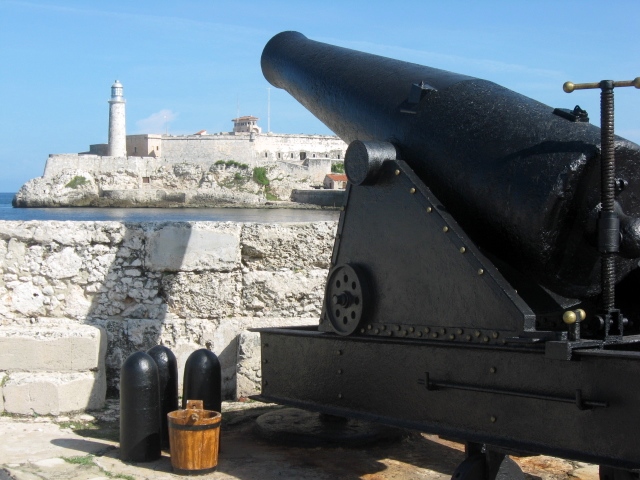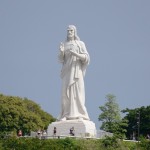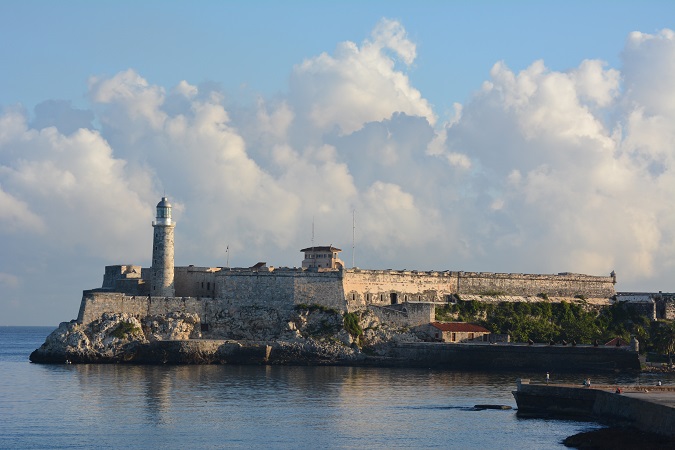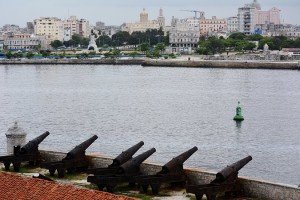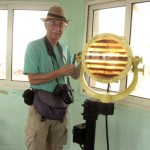
If you like Forts, You will Love Havana
Your Guide to Havana Forts
Updated Apr 2022
Castillo de San Salvador de la Punta (Fort San Salvador)

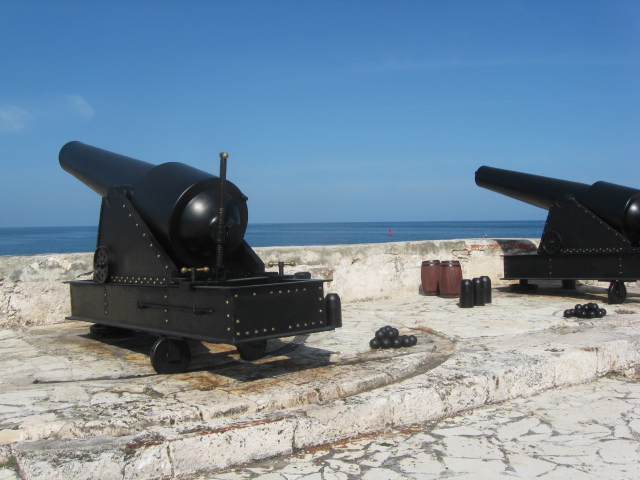
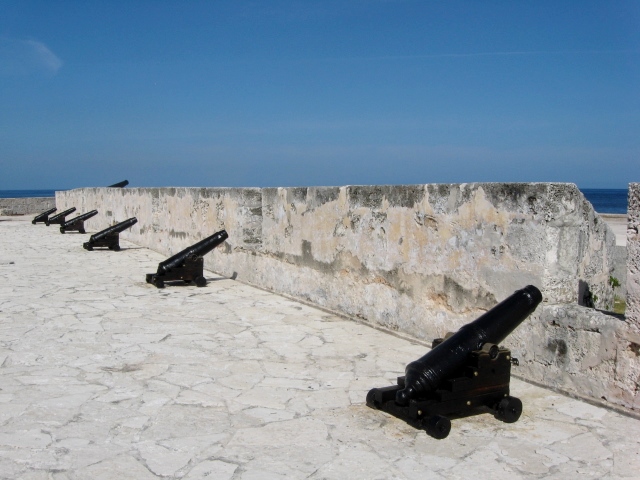

This is the easiest of Havana forts to find. It is located where the Malecon (sea-coast walkway) meets the entrance to the harbour. Work began in 1590. The fort was restored in 1997 and again in 2015, so it has been returned to its former condition after long years of neglect. Note the fresh paint on the cannon.
The room in the photo above is the ammunition room. Note the holes in the roof where ammo was passed up to the cannon above.
This fort, together with the one on the other side (Fort Morro), was built to protect the Havana harbour entrance (info on Fort Morro below).
Forts vs Castles
In Spanish, Havana Forts are often referred to as Castillos (castles). However, using an English definition, they are forts and not castles. A castle has a central building called a “keep” that is not attached to the high walls. They were defended by archers who could fire down on individuals close to the wall. Castles were built to protect a rich family or royalty and were often built in remote locations.
On the other hand, a fort is a military installation manned by soldiers
Castillo de la Real Fuerza (Fort of the Royal Force)
Fort Real Fuerza is a wonderful star-shaped fort with a water-filled moat. It is located in the old city of Havana on the shore of the harbour. It was built to protect the city of Havana from Pirates. Work began on the foundation and moat in 1558, but the first stones were not laid until 1562. It was completed in 1577. The watchtower was added in 1634.
It is in a poor location for protecting either the harbour or the city. If an enemy could reach this fort, they are already in the harbour or the city. For a fort, location is of extreme importance. A strong fort in the wrong location is useless.
Fortaleza de San Carlos de la Cabana (Fort San Carlos)
This colossal fort is located across the harbour from the old city. There are two ways to cross the harbour. There is a tunnel near the harbour entrance, or you can take the ferry. If you are capable of a long walk, I suggest taking the ferry across and walking from the village of Casa Blanca to the fort and then on to Fort Morro and then returning by taxi through the tunnel ($5). Go through the little village after getting off the ferry and turn left on the road out of the village. If you are not sure where you are going, ask for directions to the statue of Christ. You will pass this huge statue on your way to the fort. (You might also pass a roadside coconut stand where you can drink coconut milk from the shell and then eat the coconut meat.)
Mythatchedhut Travel Tip
The ferry dock is a little challenging to find. There are no signs. Walk down the harbour road inland until you pass the huge port building. The ferry terminal is across the street from a Russian Orthodox Church. Two different ferries leave from here. Get in the line for the village of Casa Blanca, which is straight across the harbour. There are no tickets. You will see a man with his hand out as you board the ferry. Make sure each person has 25 centavos. You won’t get any change.
Don’t take Photos from the Road
After passing the statue of Christ, you will come to a display of Russian military items, including an aircraft and some missiles. Don’t take any photos here until after you have paid your entrance to Fort San Carlos at the little roadside booth. The military display is included with your fee to see the fort. (You will pass a prominent complex on the right side of the road before getting to the fort, which looks like a large college campus. Again, don’t take any photos here. This is a military base.)
A Bit of History
The fort is strategically positioned to protect the harbour on one side and to protect from a land invasion on the other side.
First, a bit of history to explain why the fort was built. Havana was attacked by the British in 1762 as part of their war with Spain. The British could not get past Fort San Carlos and Fort Moro on either side of the harbour entrance, so they landed further along the coast and attacked and captured Fort Moro by the landward side. The Spanish wanted Cuba back, so they traded their colony of Florida for Cuba after the war. Florida later became part of the USA in the American War of Independence. A war between Britain and Spain resulted in Florida becoming part of the USA instead of part of Latin America. As a result of this failure, Fort San Carlos was built inland from Fort Morro to protect the landward side of the other fort and the harbour and the city of Havana.
Work began in 1763 and was completed in 1774. This massive fort is 700 metres in length and covers an area of ten hectares. It was never attacked.
The 9 pm Cannon
Every evening, a cannon was fired from the fort at 9 pm to warn the people that the city’s gates were about to close for the night. Although the wall around Havana is long gone, the ceremony of firing the cannon every night continues. Men in period costumes fire the gun. Be there by 8:30 if you want to see the ceremony.
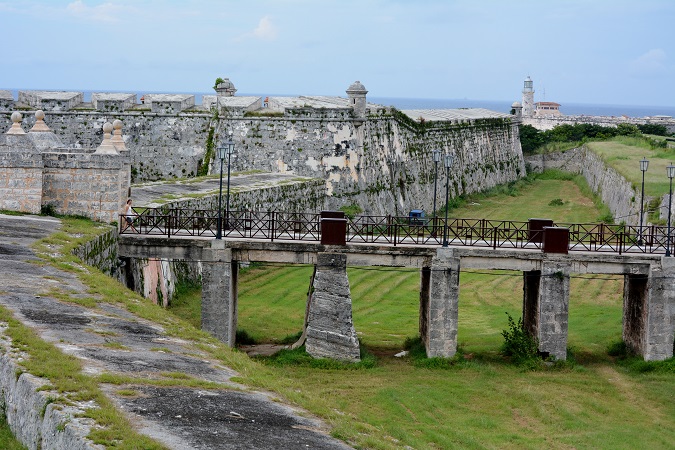
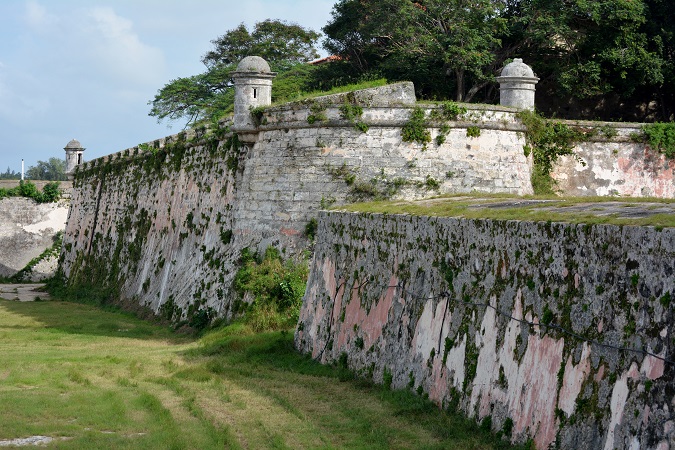
You will enter the fort by a rear entrance. Go straight ahead until you can see the main entrance and the bridge over the moat. You will pass through the fort and exit by the main gate at the other end. Proceed down the stairs and across the now dry moat and enter the fort.
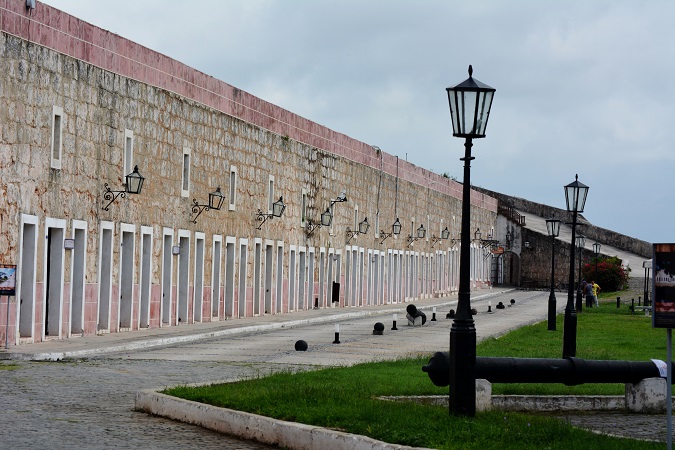
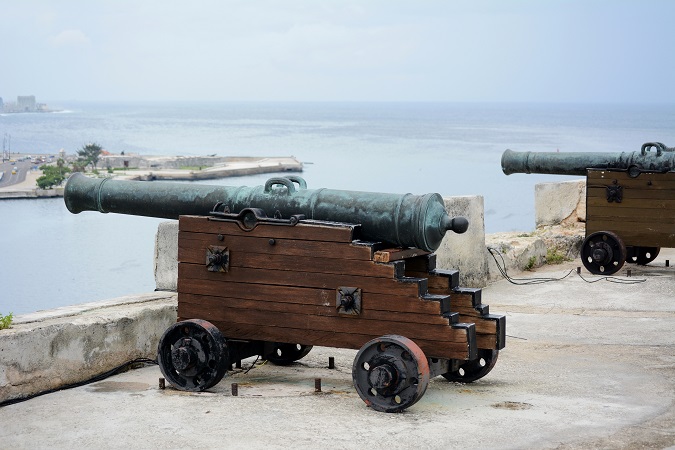
The photo above shows rows of soldiers’ quarters. You can see a ramp at the back where cannons and ammunition could be hauled up to the roof. (great views of the city of Havana from here)
After touring the fort, continue walking toward the coast to get to Fort Morro.
Castillo de los Tres Santos Reyes Magnos del Morro (Fort Morro)
This fort is across the harbour from Fort San Salvador. These two forts were built to protect the entrance to the harbour. They were successful in that, but Fort Morro was attacked and captured by the landward side by the British in 1762 (see Fort San Carlos above). The fort was built in 1589.
This fort is not as well maintained as the others. The huge cannon rusts away, whereas the gun at the other defences has been restored and painted.
A lighthouse was built within the fort in 1846.
The Harbour Captain
You will notice a little building on top of the fort. In this room, the Harbour Captain controls the entrance of all ships into Havana Harbour. He communicates with the ships by radio or Morse code with a signal lamp and sends out a pilot boat to guide the ship. He then raises a flag to show the country of the vessel. From the city of Havana, across the harbour, if you have binoculars, you can see what flag is flying and thus identify any ships in Havana harbour.
This is primarily a lonely job, and the Captain welcomes visitors. He will be happy to explain his job to you (you will be expected to leave a tip). It is interesting and worth a few minutes of your time. This photo shows me sending a message by Morse code with a light. He was surprised that I could do that (something I learned from my time in the military).
Commandancia General
Although this looks like an old fort, it was built in 1939. It is the Havana Police Station. It is located in the old city near the harbour. The police do not like to have photos taken here, and you cannot even sit on the small stone wall near the entrance (a police officer will probably come out and ask you to leave).
Castillo del Principe
Located in the centre of Havana and is challenging to find. Don’t even bother trying to see it as the Cuban military occupies it.
Enjoy your tour of Havana Forts. Here are some other posts on this website about Cuba
